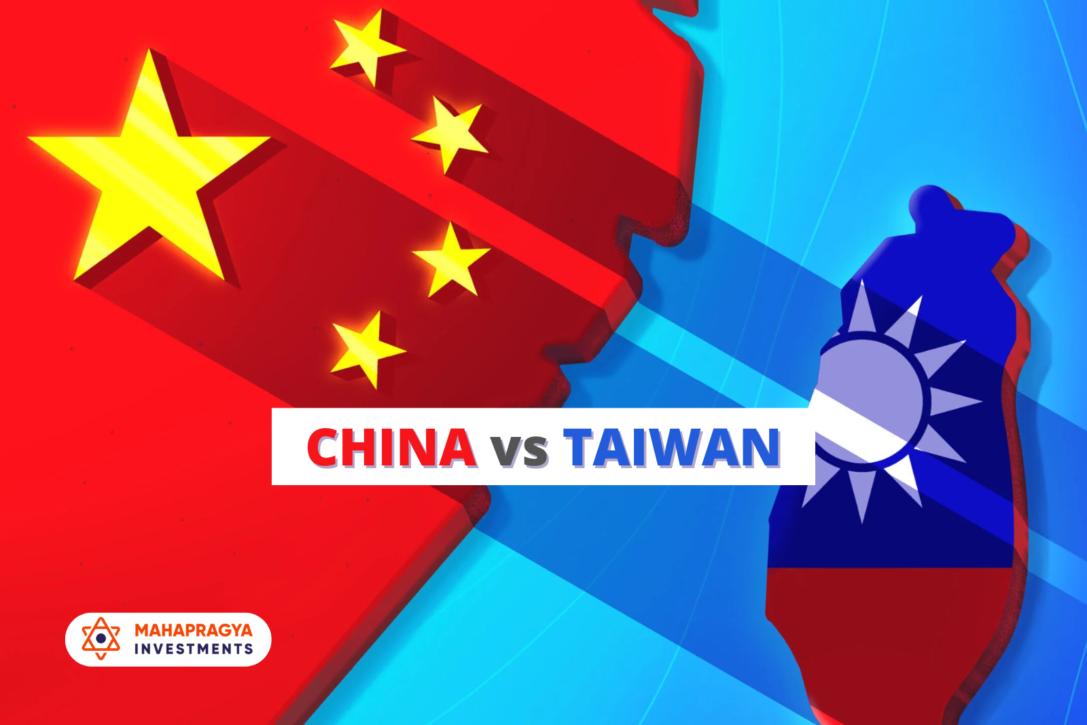
The simmering tension between China and Taiwan casts a long shadow across the Indo-Pacific region, with the potential to erupt into a full-blown conflict. This potential flashpoint has significant implications for India, not only in terms of security concerns but also for the delicate balance of its economic trajectory. This blog delves into the complexities of the China-Taiwan controversy, explores potential scenarios, and analyzes the multifaceted impact it could have on the Indian economy.
Understanding the China-Taiwan Contention
The core of the issue lies in the “One China” policy, where China views Taiwan as a breakaway province that must ultimately be reunified with the mainland, even by force if necessary. Taiwan, on the other hand, considers itself a self-governing democratic state. This historical baggage and conflicting claims of sovereignty fuel the ongoing tensions.
Potential Scenarios and Their Economic Ramifications
While a full-scale military conflict remains a worst-case scenario, various possibilities could unfold, each with distinct economic consequences for India.
- Peaceful Resolution: This scenario, though unlikely in the short term, would be the most favorable for global and Indian economies. Trade would continue uninterrupted, and supply chains would remain intact.
- Economic Coercion: China might leverage its economic muscle to pressure Taiwan. This could involve trade restrictions, disrupting crucial supply chains for India, particularly in the crucial semiconductor sector.
- Military Blockade: A Chinese blockade of Taiwan would severely disrupt global trade, especially through the vital South China Sea route. India’s imports and exports would face significant bottlenecks, leading to price hikes and shortages of essential goods.
- Full-Blown Conflict: A military confrontation would be a global economic disaster. Global trade would grind to a halt, financial markets would collapse, and energy prices would skyrocket. India’s economic growth would be severely hampered, with the potential for hyperinflation and widespread unemployment.
India’s Economic Vulnerabilities
India’s dependence on China for critical imports like semiconductors makes it particularly susceptible to disruptions. These tiny chips are the backbone of modern electronics, essential for everything from smartphones to medical equipment. Taiwan dominates the global semiconductor manufacturing landscape, and a conflict could severely restrict access to these crucial components.
Beyond semiconductors, India’s trade ties with both China and Taiwan are extensive. A disruption in this delicate balance could lead to shortages of essential goods, price hikes, and a slowdown in key sectors like automobiles, telecommunications, and electronics manufacturing.
Opportunities Amidst Uncertainty
Despite the challenges, India has a chance to leverage the situation to strengthen its economic position. Here are some potential opportunities:
- “China Plus One” Strategy: India can position itself as a viable alternative to China in global supply chains. By attracting foreign investments and fostering domestic manufacturing capabilities, India can reduce its dependence on a single source.
- Deepening Ties with Taiwan: India can enhance its economic cooperation with Taiwan, particularly in the semiconductor sector. This could involve joint ventures, technology transfers, and talent exchange programs.
- Boosting Domestic Production: The crisis underscores the need for India to bolster its domestic manufacturing capabilities in critical sectors. Government initiatives can incentivize local companies and attract foreign direct investment (FDI) in these areas.
Navigating the Tightrope: India’s Strategic Response
India walks a tightrope, balancing its economic ties with China with its growing strategic partnership with the US and other like-minded democracies. Here are some potential strategies for India:
- Maintaining Strategic Autonomy: India needs to maintain its strategic autonomy and avoid being drawn into a potential US-China conflict. It can advocate for peaceful dialogue and a rules-based order in the Indo-Pacific region.
- Diversifying Trade Partners: India should diversify its trade partnerships, reducing its dependence on China and fostering stronger economic ties with Southeast Asian nations and other democracies in the region.
- Investing in Regional Security: India can contribute to regional security by collaborating with other countries in the Indo-Pacific to ensure freedom of navigation and uphold international law.
Conclusion: The Need for a Multi-Pronged Approach
The China-Taiwan controversy presents a complex challenge for India. While the potential economic ramifications are significant, India also has opportunities to emerge stronger from this period of uncertainty. By adopting a multi-pronged approach that focuses on economic diversification, strategic autonomy, and regional collaboration, India can navigate this tightrope and safeguard its economic future.





